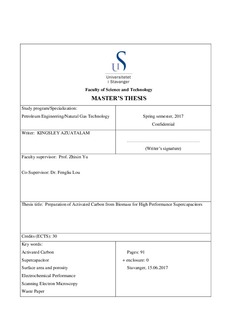Preparation of Activated Carbon from Biomass for High Performance Supercapacitors
Master thesis
Submitted version
Permanent lenke
http://hdl.handle.net/11250/2462638Utgivelsesdato
2017-06-15Metadata
Vis full innførselSamlinger
Sammendrag
Activated carbon was successfully synthesized from waste paper by physical, chemical and a combination of both activation procedures. The chemically activated carbon samples was achieved by using H3PO4 and KOH as agents. The samples exhibited hierarchical pore structures, and showed adsorption isotherms range from type 1 to type 5. The samples were analysed by Nitrogen Physisorption to determine the surface area and pore size distribution, and characterization by Scanning electron microscopy (SEM) examinations with energy dispersive x-ray spectroscopy (EDX) to study the surface morphology. The achieved activated carbon had surface area of 1014m2=g, with a narrow pore size distribution (of about 2 nm). In addition to this, the SEM and EDX results shows that samples with irregular pore size distribution and low surface area had other major elements in their structure asides from the usual carbon, calcium and oxygen.
When utilized as electrode material to evaluate their capacitive performance, the samples presented impressive rate capabilities, as a result of high values of specific capacitance (114 F=g), and energy density (26.7 Wh=Kg). These numbers were considerably higher than that obtained from a state-of the art reference material (106 F=g and 24.84 Wh=Kg). From the analysis, we can easily decipher that a temperature of 850 C and Potassium hydroxide for 60 - 120 minutes gives the best results.
Beskrivelse
Master's thesis in Petroleum engineering
